How the refrigerator works: device and principle of operation of the main types of refrigerators
A clear understanding of the device and the processes occurring inside the refrigeration unit helps to extend the life of the equipment. It’s easy to understand how the refrigerator works. In any model, it consists in the formation of a cold environment by absorbing heat in the internal part of the object and its subsequent removal outside the device.
You will learn all about how refrigerators with different operating principles work from the article we presented. We will talk about the features of the device and related operating rules. Our tips will help protect chillers from premature breakdowns and save you the trouble of repairing them.
The content of the article:
The principle of operation of the main types of refrigerators
Refrigeration equipment is used in many fields of activity. You can’t do without it in everyday life and it is impossible to imagine the full-fledged work of production shops at enterprises, trading floors, public catering establishments.
Depending on the intended purpose and scope, there are several main types of devices: absorption, vortex, thermoelectric and compressor.
The compressor type is the most common, so we will consider it in more detail in the next section. Now let's outline the main differences between all 4 constructs.
The operation of absorption technology
Two substances circulate in the system of absorption type plants - refrigerant and absorbent. The functions of the refrigerant are usually performed by ammonia, less often acetylene, methanol, freon, lithium bromide solution.
The absorbent is a liquid that has sufficient absorption capacity. It can be sulfuric acid, water, etc.

Elements of the system are connected by tubes, with the help of which a single closed loop is formed. The cooling of the chambers is due to thermal energy.
The process is as follows:
- a refrigerant dissolved in a liquid penetrates the evaporator;
- ammonia vapors boiling at 33 degrees are released from the concentrated solution, cooling the object;
- the substance passes into the absorber, where it is again absorbed by the absorbent;
- the pump pumps the solution into a generator heated by a specific heat source;
- the substance boils and the ammonia vapors released go into the condenser;
- the refrigerant cools and transforms into a liquid;
- the working fluid passes through the control valve, is compressed and sent to the evaporator.
As a result, the ammonia circulating in a closed circuit takes heat from the cooled chamber and enters the evaporator. And gives it to the environment, being in the capacitor. Loops play non-stop.
Since the unit cannot be turned off, it is not very economical and has an increased energy consumption. If such equipment fails, it will most likely fail to repair it.

In the design of devices there are no bulky moving and rubbing elements, so they have a low noise level. The devices are relevant for buildings whose electrical network is subjected to constant peak loads, and places where there is no constant power supply.
The absorption principle is implemented in industrial refrigeration units, small refrigerators for cars and office premises. Sometimes it is found in individual household models that operate on natural gas.
The principle of operation of thermoelectric models
The temperature reduction in the chamber of the thermoelectric refrigerator is achieved using a special system that pumps heat according to the Peltier effect. It implies the absorption of heat in the area of the connection of two different conductors at the time of passage of electric current through it.
The design of refrigerators consists of thermoelectric elements in the form of a cube made of metals. They are combined by one electrical circuit. Along with the movement of current from one element to another, heat also moves.
The aluminum plate absorbs it from the inner compartment, and then transfers it to the cubic working parts, which, in turn, perform a redirection to the stabilizer. There, thanks to the fan, it is thrown out. By this principle, portable mini fridges and bags with a cooling effect.
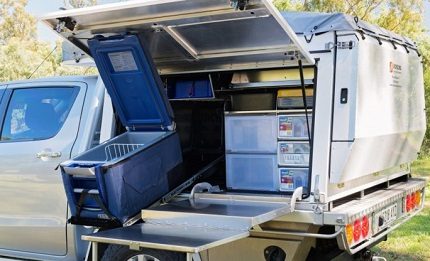
This equipment is used in camping, in the field of arranging cars, yachts and motor boats, often placed in cottages and in other places where it is possible to provide the device with power supply with a voltage of 12 V.
In thermoelectric products, a special emergency mechanism is provided, which turns them off in case of overheating of working parts or a failure of the ventilation system.
The advantages of this method of operation include high reliability and a fairly low noise level during the operation of devices. Among the disadvantages are the high cost, sensitivity to external temperatures.
Features of equipment on vortex coolers
In devices of this category there is a compressor.It compresses the air, which further expands in the installed units of the vortex coolers. The object cools due to a sharp expansion of compressed air.
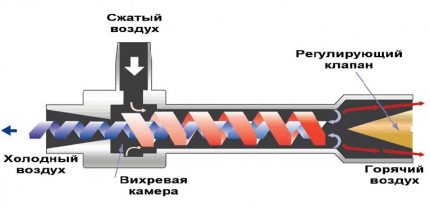
The vortex cooler method was not widely used, and was limited only to test samples. This is explained by high air consumption, very noisy operation and relatively low cooling capacity. Sometimes devices are used in industrial enterprises.
Compressor Technology Overview
Compressor refrigerators are the most common type of household equipment. They are in almost every home - they do not consume too many energy resources and are safe to operate. The most successful models of reliable manufacturers have been serving their owners for more than 10 years. Consider their structure and the principles by which they work.
Features of the internal device
A classic household refrigerator is a vertically oriented cabinet equipped with one or two doors. Its body is made of rigid sheet steel with a thickness of about 0.6 mm or durable plastic that facilitates the weight of the supporting structure.
For high-quality sealing of the product, paste with a high content of vinyl chloride is used. The surface is primed and covered with high-quality enamel from spray guns. In the production of internal metal compartments, the so-called stamping method is used, plastic cabinets are made according to the vacuum molding method.
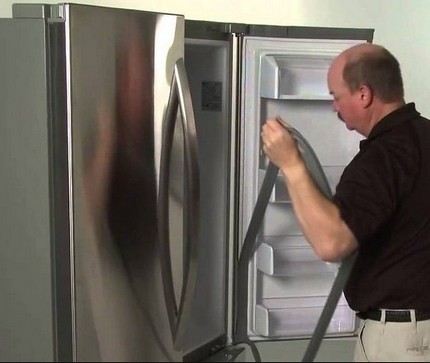
Between the inner and outer walls of the product, a thermal insulation layer is necessarily laid, which protects the camera from heat trying to penetrate from the environment, and prevents the loss of cold formed inside. Mineral or glass felt, polystyrene foam, polyurethane foam are well suited for these purposes.
The interior space is traditionally divided into two functional areas: refrigeration and freezer.
According to the layout, they distinguish:
- one-;
- two;
- multi-chamber devices.
In a separate view highlighted Side-by-Side aggregatesincluding two, three or four cameras.
Single chamber units are equipped with one door. In the upper part of the equipment there is a freezer compartment with its own door with a folding or opening mechanism, and in the lower part there is a refrigeration section with shelves adjustable in height.
In the cameras, lighting equipment with an LED or an ordinary incandescent lamp is installed in order to see what, in fact, lies in the refrigerator.
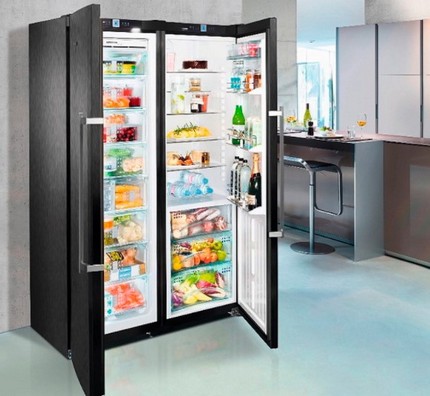
In two-chamber units, the internal cabinets are isolated and separated by their own doors. The location of departments in them can be European and Asian. The first option involves the lower layout of the freezer, the second - the upper.
Constituent structural elements
Compressor-type refrigeration units do not produce cold. They cool the object by absorbing internal heat and redirecting it to the outside.
The procedure for the formation of cold proceeds with the participation of the following nodes:
- cooling agent;
- capacitor;
- evaporative radiator;
- compressor unit;
- thermostatic valve.
The refrigerant used to fill the refrigerator system is played by various brands of freon - a mixture of gases with a high level of fluidity and fairly low boiling / evaporation temperatures. The mixture moves in a closed loop, transferring heat to different parts of the cycle.
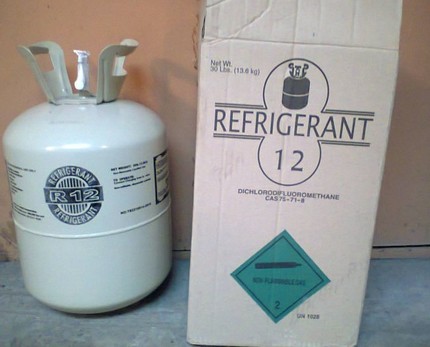
Compressor - The central part of the design of any refrigerator. This is an inverter or linear unit that provokes forced circulation of gas in the system, pumping pressure. Simply put, refrigerator compressor compresses the freon pairs and makes them move in the right direction.
The equipment can be equipped with one or two compressors. Vibrations arising during operation are absorbed by the external or internal suspension. In models with a pair of compressors, a separate device is responsible for each chamber.
There are two subtypes of compressor classification:
- Dynamic. Forces the refrigerant to move due to the force of movement of the blades of a centrifugal or axial fan. It has a simple structure, but due to low efficiency and rapid wear under the influence of torque in household equipment is rarely used.
- Volume. It compresses the working fluid using a special mechanical device that is started by an electric motor. It happens piston and rotary. Basically in refrigerators such compressors are installed.
Piston unit It is presented in the form of an electric motor with a vertical shaft enclosed in a one-piece metal casing. When the start relay connects power, it activates the crankshaft, and the piston mounted on it starts to move.
A system of opening and closing valves is connected to the work. As a result, freon pairs are pulled from the evaporator and pumped into the condenser.

In rotor mechanisms, the necessary pressure is maintained by two rotors moving towards each other. Freon enters the upper pocket located at the beginning of the shafts, is compressed and exits through the lower hole of a small diameter. To reduce friction, oil is introduced into the space between the shafts.
Capacitors are made in the form of a coil grill, which is fixed on the back or side wall of the equipment.
They have a different design, but they are always responsible for one task: cooling hot gas vapors to preset temperatures by condensing the substance and dissipating heat in the room. They are shield or rib-tubular.
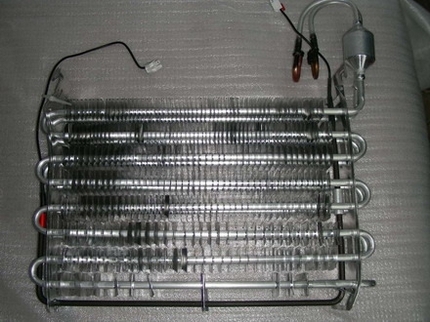
Thermostatic expansion valve needed in order to maintain the pressure of the working fluid at a certain level. Large units of the unit are interconnected by a system of tubes forming a tight closed ring.
Duty Cycle
The optimum temperature for long-term storage of provisions in compression devices is created during work cycles that are carried out one after another.
They proceed as follows:
- when the device is connected to the mains, a compressor starts, compressing the freon pairs, simultaneously increasing their pressure and temperature;
- under the force of excess pressure, a hot working fluid in a gas state of aggregation enters the capacitor;
- moving along a long metal tube, steam releases the accumulated heat into the environment, cools down to room temperature values and turns into a liquid;
- a liquid working fluid passes through a filter drier that absorbs excess moisture;
- the refrigerant penetrates through a narrow capillary tube, at the outlet of which its pressure decreases;
- the substance cools and is converted into gas;
- chilled steam gets to the evaporator and, passing through its channels, takes heat from the internal compartments of the refrigeration unit;
- Freon temperature rises, and he again goes to the compressor.
In simple terms, how the compressor refrigerator works, the process looks like this: the compressor distills the refrigerant in a vicious circle. Freon, in turn, changes the state of aggregation due to special devices, collects heat inside and transfers it outside.
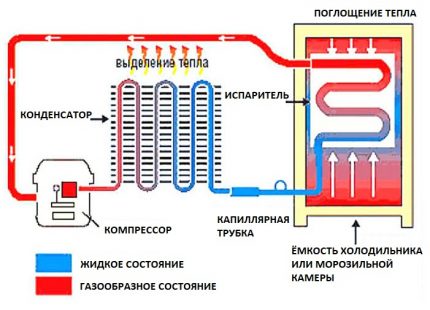
After cooling to the desired parameters, the temperature controller stops the motor, breaking the electrical circuit.
When the temperature in the chambers begins to rise, the contacts close again, and the compressor motor is driven protective start relay. That is why, during the operation of the refrigerator, the hum of the motor constantly appears and then again subsides.
Recommendations for use and care
There is nothing complicated in the operation of the equipment: it operates automatically around the clock. The only thing that needs to be done the first time you turn it on and periodically adjust it during operation is to establish the optimum temperature regime in specific circumstances.
The desired temperature is set thermostat. In an electromechanical system, values are set by eye or in accordance with the recommendations specified in the manufacturer's instructions. In this case, the type and quantity of products stored in the refrigerator should be taken into account.
The knob, as a rule, is a round mechanism with several divisions, or, in models more modern and more expensive, control can be carried out using the touch panel.
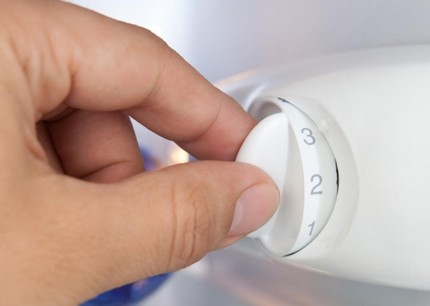
Each mark on such a pen corresponds to a specific temperature regime: the greater the division, the lower the temperature. The electronic unit allows you to set the temperature with a maximum accuracy of 1 degree using the rotary knob or buttons.
For example, set the freezer compartment to -14 degrees. All entered parameters will be displayed on a digital display.
To maximize the life of a home refrigerator, you should not only understand its device, but also competently care for it. Lack of proper service and improper operation can lead to rapid wear of important parts and malfunctioning.
You can avoid undesirable consequences by adhering to a number of rules:
- Clean the condenser regularly from dirt, dust and cobwebs in models with an open metal grill on the back wall. To do this, use an ordinary slightly moistened rag or vacuum cleaner with a small nozzle.
- Install the equipment correctly. Ensure that the distance between the condenser and the wall of the room is not less than 10 cm. This measure will help ensure unhindered circulation of air masses.
- Defrost on time, preventing the formation of an excessive layer of snow on the walls of the chambers. At the same time, to eliminate ice crusts, it is forbidden to use knives and other sharp objects that can easily damage and disable the evaporator.
It should also be borne in mind that the refrigerator should not be placed next to heating appliances and in places where direct contact with sunlight is possible. Excessive influence of external heat adversely affects the operation of the main components and the overall performance of the device.
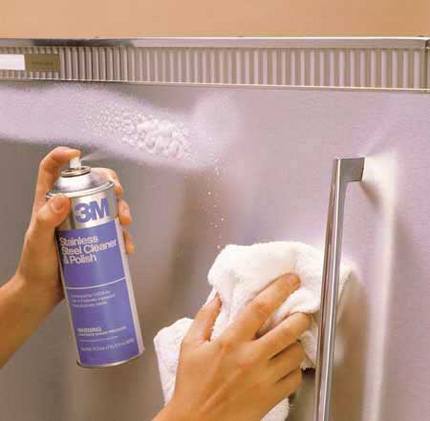
If you plan to transport from place to place, it is best to transport the equipment in a truck with a high van, fixing it in a strictly vertical position.
Thus, it is possible to prevent breakdowns, oil leakage from the compressor entering directly into the circulation circuit of the cooling agent.
Conclusions and useful video on the topic
Video # 1. How the refrigeration unit works:
Video # 2. Detailed explanation of the compression refrigeration device:
Video # 3. Information on the operation of absorption machines:
While refrigeration equipment is working properly, consumers are rarely interested in its design. However, this knowledge should not be neglected. They are very valuable because they allow you to quickly determine the cause of the breakdown and find the problem place, preventing serious malfunctions.
Please leave comments, post thematic photographs, ask questions about the topic of the article in the block below. Tell us how you understood the design of your own refrigerator. Share how you put into practice the knowledge about the design of the chiller.

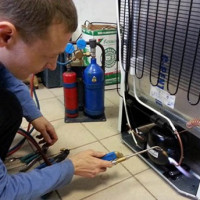 Why doesn't the refrigerator work, and does the freezer work? Troubleshooting and troubleshooting
Why doesn't the refrigerator work, and does the freezer work? Troubleshooting and troubleshooting 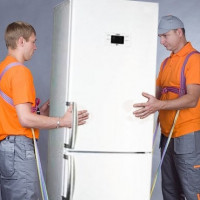 Can I carry the refrigerator while lying down? Rules and standards for the transportation of refrigerators
Can I carry the refrigerator while lying down? Rules and standards for the transportation of refrigerators 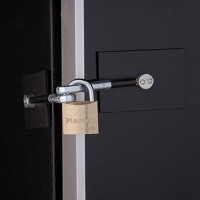 Fridge lock: types, device, how and which is better to choose
Fridge lock: types, device, how and which is better to choose 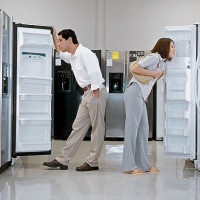 How to choose a refrigerator: which refrigerator is better and why + rating of the best models
How to choose a refrigerator: which refrigerator is better and why + rating of the best models 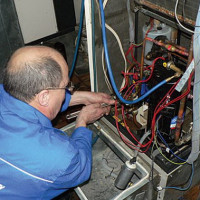 Stinol Refrigerator Repair: Frequent Problems and Solutions
Stinol Refrigerator Repair: Frequent Problems and Solutions 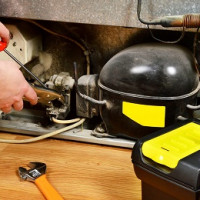 Why the refrigerator does not turn off: an overview of frequent breakdowns and how to fix them
Why the refrigerator does not turn off: an overview of frequent breakdowns and how to fix them  How much does it cost to connect gas to a private house: the price of organizing gas supply
How much does it cost to connect gas to a private house: the price of organizing gas supply  The best washing machines with dryer: model rating and customer tips
The best washing machines with dryer: model rating and customer tips  What is the color temperature of light and the nuances of choosing the temperature of the lamps to suit your needs
What is the color temperature of light and the nuances of choosing the temperature of the lamps to suit your needs  Replacement of a geyser in an apartment: replacement paperwork + basic norms and requirements
Replacement of a geyser in an apartment: replacement paperwork + basic norms and requirements
Everything is detailed, everything is intelligible even for a woman. 🙂 The only question left is know-frost refrigerators: due to what they do not form ice inside? As I understand it, moisture is removed from the air, and there will simply be nothing to get from the ice. But apparently, this implies that the electricity consumption of the know-frost refrigerators will be much higher than that of a conventional one. How big is this difference?
In fact, the difference is significant. A conventional two-chamber refrigerator consumes about 230-250 kW per year, and with Nou Frost up to 600 kW. But much also depends on the energy saving class.
That's right, there are some nuances of using equipment that you do not always know. I used to love putting hot water in the refrigerator to cool off faster or hot soup, now I know that I just ruined the equipment with my own hands. And to cool the water faster, just throw in the ice from the freezer. For the same reason, you can not put hot water, tea and in the freezer.
I read - had fun. Solid aphorisms, such as “The knob is a circular mechanism with several divisions.” It turns out that the handle is already ranked among the mechanisms. And in that spirit, the entire technical part of the article.
Smile is helpful 🙂
But seriously - it’s about a temperature control mechanism that works when you turn the knob in one direction or another. I think you yourself understood this, it just seems like you wanted to find fault. Other things are written in the most simplified layman language, we try not to complicate anything on purpose.